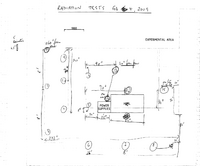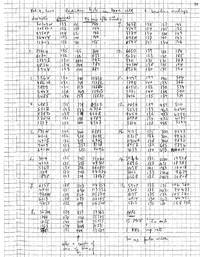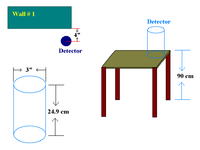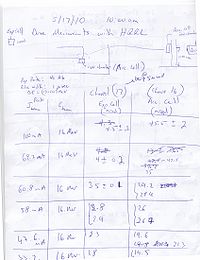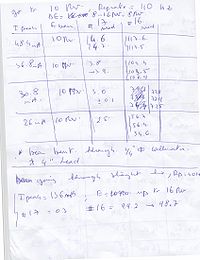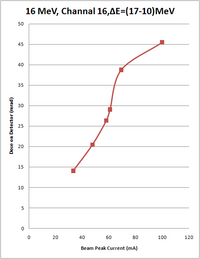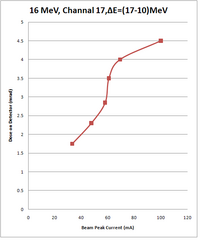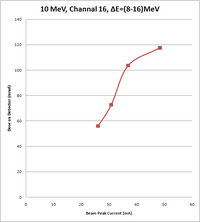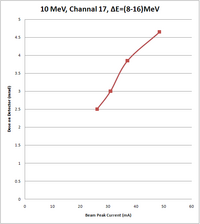Difference between revisions of "HRRL radiation tests"
| Line 1: | Line 1: | ||
Building a new positron beamline in the HRRL cell might require moving the linac itself. To help assess whether this is feasible with current shielding, radiation levels were measured on Feb 4, 2009 by M. Balzer and G. Stancari. | Building a new positron beamline in the HRRL cell might require moving the linac itself. To help assess whether this is feasible with current shielding, radiation levels were measured on Feb 4, 2009 by M. Balzer and G. Stancari. | ||
| − | The HRRL was set at 15 MeV beam energy, 20 mA peak current, 1 kHz repetition rate, and 30 ns pulse width. Five OSL dosimeters (For Details on OSL dosimeter, look | + | The HRRL was set at 15 MeV beam energy, 20 mA peak current, 1 kHz repetition rate, and 30 ns pulse width. Five OSL dosimeters (For Details on OSL dosimeter, look [[http://wiki.iac.isu.edu/index.php/HRRL_radiation_tests#OSL_dosimeter]]) were placed at each of 15 locations in the cell. Locations are marked on the following map: |
[[Image:dosimeter-locations-20090204.png | 200px ]] | [[Image:dosimeter-locations-20090204.png | 200px ]] | ||
Revision as of 20:40, 24 May 2010
Building a new positron beamline in the HRRL cell might require moving the linac itself. To help assess whether this is feasible with current shielding, radiation levels were measured on Feb 4, 2009 by M. Balzer and G. Stancari.
The HRRL was set at 15 MeV beam energy, 20 mA peak current, 1 kHz repetition rate, and 30 ns pulse width. Five OSL dosimeters (For Details on OSL dosimeter, look [[1]]) were placed at each of 15 locations in the cell. Locations are marked on the following map:
Media:dosimeter-locations-20090204.pdf
Readings in mrad are reported in the following table. They were taken before exposure (first column) and after a couple of minutes of machine tuning (second column). Readings in the third column were taken 94 minutes after the second reading. During these 94 minutes, the machine was running with the settings mentioned above.
Media:exposure-measurements-20090204.pdf
Dose rates in mrad/hr at each of the 15 locations can be estimated by subtracting column 2 from column 3, averaging over the 5 dosimeters, and multiplying the result by (60 min/hr) / (94 min). RMS spreads refer to variations within each group of 5.
| Location | Dose rate | RMS spread |
|---|---|---|
| (mrad/hr) | (mrad/hr) | |
| 1 | 9 | 4 |
| 2 | 396 | 57 |
| 3 | 7940 | 204 |
| 4 | 2831 | 117 |
| 5 | 4408 | 373 |
| 6 | 29339 | 3332 |
| 7 | 72517 | 687 |
| 8 | 36507 | 4746 |
| 9 | 5 | 5 |
| 10 | 37 | 4 |
| 11 | 164 | 40 |
| 12 | 2734 | 313 |
| 13 | 5828 | 120 |
| 14 | 7793 | 2579 |
| 15 | 62431 | 27155 |
OSL dosimeters
Experimental Cell Dose Measurement with HRRL
This experiment is done on 5/17/2010, at 10:00 am.
Dr. Khalid Chouffani wrote the note. Here is photocopy of his note:
page #1
page #2
16 MeV Beam Energy
Experimental cell measurement with HRRL.
Conditions are:
Rap rate: 40 Hz
Pulse width: 1
E=(10-17) MeV
| Peak current of beam (mA) | Energy of beam (MeV) | Measurement on Channel 17, Experimental Cell (mrad) | Measurement on Channel 16, Accelerator cell (mrad) |
| 100 | 16 | 4.5 0.2 | 45.5 2 |
| 69.2 | 16 | 4 0.2 | 35, 42.5 |
| 60.8 | 16 | 3.5 0.1 | 29.2, 28.9 |
| 58.0 | 16 | 2.8, 2.9 | 26, 26.7 |
| 47.6 | 16 | 2.3 | 19.6, 21.3 |
| 33.2 | 16 | 1.8, 1.7 | 19.5, 19.0, 13.7 |
Beam bear through 1/4 inches diameter collimator with 4 inches lead.
16 MeV Beam Energy
Conditions are:
Rap rate: 40 Hz
| Peak current of beam (mA) | Energy of beam (MeV) | Measurement on Channel 17, Experimental Cell (mrad) | Measurement on Channel 16, Accelerator cell (mrad) |
| 136 | 16 | 0.3 | 99.2, 98.7 |
10 MeV Beam Energy
Conditions are:
Rap rate: 110 Hz
E=(8-16) MeV
| Peak current of beam (mA) | Energy of beam (MeV) | Measurement on Channel 17, Experimental Cell (mrad) | Measurement on Channel 16, Accelerator cell (mrad) |
| 48.4 | 10 | 4.6, 4.7 | 117.6, 117.5 |
| 36.8 | 10 | 3.8, 3.9 | 104.4, 103.5, 102.9 |
| 30.8 | 10 | 3.1 0.1 | 72.8, 72.9, 72.5 |
| 26 | 10 | 2.5 | 56.7, 56.4, 54.6 |
Channel 17 Dose Estimation in New Position
Channel 17 is a dose measuring detector on in the HRRL experimental cell.
Calculating Number of Particles Per Second
We have electron beam of:
Frequency: f (Hz)
Peak current: I (mAmp = 0.001 Amp)
Pulse width: t ( seconds )
So, how many electrons we have in each second?
By Q=It, we have
Where N is the total electron numbers hits target per second, e is electron charge and f, I and are given above. So
Number of Particles Per Second in test by M. Balzer on Feb 4, 2009
In radiation levels measured on Feb 4, 2009 by M. Balzer and G. Stancari
Five OSL dosimeters were placed at each of 15 locations in the cell. (What is OSL? Need to ask M. Balzer)
The HRRL was set at 15 MeV beam energy, 20 mA peak current, 1 kHz repetition rate, and 30 ns pulse width.
Number of Particles Per Second in "Experimental Cell Dose Measurement with HRRL" on 5/17/201
This is the experiment we have done on 5/17/201 to measure dose on the detector placed in the corner of the doorway.
Conditions are: Pulse width: 1 , Rap rate: 110 Hz.
We measured dose for several peak current. One of the peak current is 26 mA. For this peak current:
Back to Positrons
